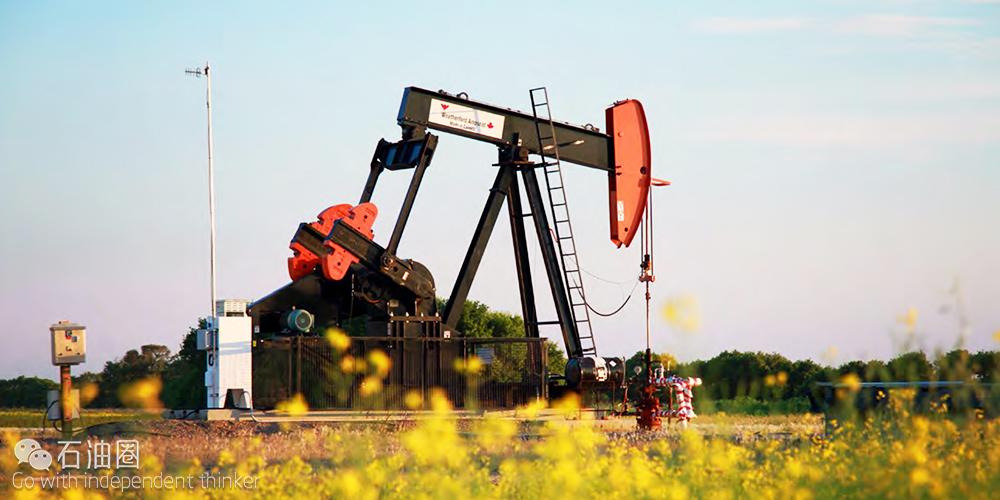
近期油价一直徘徊于50美元以下,综合多种因素分析,目前油价是在多种竞争机制下形成,国际原油市场已经不是石油垄断组织OPEC所能左右的,近期油价不仅没有继续上涨的动力,而且50美元的价格将都难以为继。
2014年11月,石油输出国组织OPEC决定大幅增加原油产量,试图用降低油价的方式将其竞争对手美国逐出石油市场。控制着全球40%的原油和60%的国际石油贸易组织的OPEC完全有能力影响全球石油市场。页岩油的繁荣已经造成原油供给过量,原油在降到最低点约27美元/桶之前,已经从2014年的峰值跌去了75%以上。之后,市场从2016年1月的油价低点,大幅反弹了67%。然而,许多经济学家预计近期石油价格上涨的趋势是短暂的,因为供应量仍在不断增加而需求量在不断下降。
日益增加的供应量
截至2016年6月,美国的石油产量达到了自1972年以来的最高水平,产量大约为900万桶/天,在过去的8年里增加了89%。如果OPEC仍按照目前的产能进行生产,那么到2016年底,产能过剩量将达到95万桶/天,比3月的预期增加了16万桶/天。
2016年,随着产量的增加,美国原油的进口量也仍在激增。根据联邦政府的数据,在2015年5月原油进口量触及近20年的低点后,到目前进口量已增加了20%至800万桶/天。这种现象是由多种因素造成的,其中包括美国对伊朗取消了经济制裁,以及过剩的原油存储库容和国内较高的运输成本。
美国撤销对伊朗的制裁
尽管伊朗没有直接向美国出口石油,但解除经济制裁间接导致美国原油进口量的上升。在2016年1月美国撤销对伊朗的制裁后,伊朗用开始用压低竞争对手的价格的方式来抢占失去的市场份额。由于伊朗压低油价,失去亚洲和欧洲市场的石油输出国,开始把石油大量卖到美国市场,这还是页岩繁荣期以来首次出现的现象。
库存过剩
2016年5月,美国原油的进口需求主要受石油贸易商驱动。这些贸易商利用他们在美国巨大的原油储存库容,持有原油并期望通过期货市场卖出高价。美国只占用了约66%的石油储存库容,还可以存储近1亿桶石油。相比之下,欧洲的存储库容已经使用了90%,而南非和中国的储库几乎已满。此外,造成进口量增长的另一原因是美国国内高昂的火车运输成本,经火车运输的原油价格比从国外进口原油还高,因此造成美国库存过剩。
需求下降
油价下跌的最主要的原因是全球原油供给量已创新的历史记录,而且需求量也在减少。2015年,对石油的需求比上年增加了154万桶/天。2016年的预测需求增长量至年底预计将放缓至120万桶/天。造成减少的原因之一是全球各国国内生产总值(GDP)增长率的下降。从2014年到2015年,全球GDP增长从3.9%下降到3.1%,预计在2016年仍将保持这一趋势,经济学家预测的增长率在2.3~2.8%之间。造成需求下降的另一个主要因素是美元的强势和反弹。随着美元走强,使用外币购买石油的价格将越来越高。根据摩根士丹利的分析,美元升值5%可能导致油价下跌10~25%。
投资选择
对于想加大石油投资的投资者,美国石油基金(United States Oil Fund LP,NYSEARCA: USO)和能源行业股票基金(Energy Select Sector SPDR Fund,NYSEARCA: XLE)是最受欢迎的选择。然而,这些基金之间有很大的区别。XLE费率低为0.14%,股息收益率高几乎达到3%,投资了全球42家石油公司,其中埃克森美孚( NYSE:XOM)和雪佛龙(NYSE:CVX)共占约33.65%的比重。其多样性的投资以及良好的股息收益率和费率,使XLE成为长线投资者的最佳选择。
而USO只适合有经验的石油领域短期投资者。由于ETF的设计,其主要投资于近月石油期货合约并跟踪每日价格波动,USO的管理费过高达0.45%,存在时间耗损。USO必须每月在到期前出售其当前的期货合约,再转到下一个月的合同。由于期货合约的定价规则,投资者越是长期看好USO,由时间耗损带来展期收益的可能性就越大。为了彻底理解这些因素如何影响USO的长线价格,投资者可以回看2009年和2010年的数据,当时石油现货价格增涨了98.74%,而USO仅上涨3.12%。
总之,近期原油价格一直在50美元上下徘徊,主要是撤销制裁的伊朗及其他OPEC国家的增产等因素造成供应量过剩,而全球经济增长放缓和美元走强等因素又造成需求量减少所致,未来我们要做好油价长期维持在50美元上下的准备。
作者/Chase Carmichael 译者/白小明 编辑/Wang Yue
In November 2014, the Organization of Petroleum Exporting Countries (OPEC) decided to increase its production of oil aggressively in an attempt to lower the price and force its U.S. competitors out of the market. Controlling 40% of global crude oil and 60% of internationally traded petroleum, OPEC is able to exert significant control over the market. Coupled with an already excessive supply created by the shale oil boom, oil had proceeded to drop by more than 75% from its peak in 2014 before bottoming out around $27. Since then, the market has made a significant rebound of 67% from its low in January 2016. However, many economists expect the recent, upward trajectory of oil prices to be short-lived, given the rising levels of supply and falling demand.
Growing Supply
As of June 2016, U.S. production is at its highest level since 1972, producing approximately 9 million barrels of oil per day (bpd), an increase of 89% over the past eight years. Additionally, OPEC is ramping up its output to 32.77 bpd, resulting in the largest rise in production since 2008. If OPEC continues to pump at this rate, then the surplus of oil is expected to jump to 950,000 bpd by the end of 2016, an increase of 160,000 bpd from the previous March estimate.
Along with production in 2016, U.S. oil imports are surging. Since approaching a 20-year low in May 2015, imports have risen by 20% to 8 million bpd, according to federal data. This phenomenon was caused by multiple factors, including a recently unsanctioned Iran, excess storage capacity and high domestic shipping costs.
Removal of Iran’s Sanctions
Despite Iran’s inability to export oil to the states, the lifting of its economic sanctions has contributed to an indirect upswing in U.S. imports. After sanctions were removed in January 2016, Iran began to undercut its competitors’ prices in an attempt to gain lost market share. Due to this underpricing, countries that had been cut out of the market in Asia and Europe took to selling to the U.S. market in a substantial manner for the first time since the shale boom.
Excess Storage Capacity
As of May 2016, demand for imports has been chiefly driven by oil traders. These traders are utilizing the relatively high excess storage capacity within the United States to hold oil and secure higher prices via the futures market. The United States has filled only approximately 66% of its total storage capacity and still has room for nearly 100 million more barrels of oil. In comparison, Europe’s storage capacity is 90% full, while those of both South Africa and China are virtually full. Moreover, the rise in imports is driven by the steep cost of transporting oil domestically by train, a process that is more expensive than importing foreign crude.
Falling Demand
While a record level of global supply promises to drive down oil prices by itself, demand is also waning. In 2015, the demand for oil had grown by 1.54 million bpd from the previous year. The forecast for 2016 predicts this growth in demand will slow to 1.2 million bpd by the end of the year. One of the causes of this slowdown is falling gross domestic product (GDP) growth worldwide. From 2014 to 2015, global GDP growth depreciated from 3.9 to 3.1%, and it is expected to maintain this trend into 2016, where economists predict the range of growth to be between 2.3 to 2.8%. Another major contributor to the decline in demand is the robust and resilient U.S. dollar. As it strengthens, oil becomes more expensive for people paying with foreign currencies. According to Morgan Stanley (NYSE: MS), a 5% increase in the dollar’s value could result in a drop in oil prices from 10 to 25%.
Investment Options
For investors looking to gain exposure to oil, the United States Oil Fund LP (NYSE Arca: USO) and the Energy Select Sector SPDR Fund (NYSEARCA: XLE) are the most popular options. However, these funds have key differences. XLE, which has a low expense ratio of 0.14% and a high dividend yield of almost 3%, invests in 42 different oil companies globally, with Exxon Mobil Corp. (NYSE: XOM) and Chevron Corp. (NYSE: CVX) making up 33.65% of its portfolio. Its diversity of investment, as well as its favorable dividend yield and expense ratio, make XLE the best choice for long-term investors.
USO is only suitable for experienced investors looking to take a short-term position in oil. Due to the design of the ETF, which invests in near-month oil futures contracts to track daily price movements, USO bears an exorbitant management fee of 0.45% and is exposed to time decay. Every month, USO must sell its current futures contracts before expiration and roll out to the next month’s contracts. Due to the pricing of futures contracts, the longer a position is held in USO, the more likely it is for roll costs to occur as a result of time decay. To fully understand how these factors can affect the USO price in the long term, investors can examine the years of 2009 and 2010, when the spot price for oil increased by 98.74%, but USO only appreciated by 3.12%.
未经允许,不得转载本站任何文章:
-

- 甲基橙
-
石油圈认证作者
- 毕业于中国石油大学(华东),化学工程与技术专业,长期聚焦国内外油气行业最新最有价值的行业动态,具有数十万字行业观察编译经验,如需获取油气行业分析相关资料,请联系甲基橙(QQ:1085652456;微信18202257875)



 石油圈
石油圈